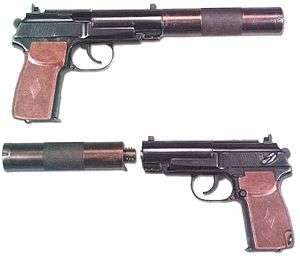PB (pistol)
The PB (Russian: Пистолет Бесшумный, romanized: Pistolet Besshumnyy, lit. 'Pistol Silent', English: Silent Pistol; GRAU index 6P9) is a Soviet integrally suppressed semi-automatic pistol developed and manufactured by Izhevsk Mechanical Plant, based on the Makarov pistol; since the merger of Izhevsk Mechanical Plant and Izhevsk Machine-Building Plant to form Kalashnikov Concern, it has continued to be manufactured by Kalashnikov Concern. It entered service in 1967.
| Pistolet Besshumnyy | |
|---|---|
 Top: A complete PB Bottom: A PB with the suppressor's front section detached | |
| Type | Integrally suppressed semi-automatic pistol |
| Place of origin | Soviet Union |
| Service history | |
| In service | 1967–present |
| Used by | KGB Soviet Army reconnaissance |
| Production history | |
| Designer | A.A. Deryagin[1] |
| Manufacturer | Izhevsk Mechanical Plant[2] (1967–2013) Kalashnikov Concern[3] (2013–present) |
| Produced | 1967–present[2][3] |
| Specifications | |
| Mass | 0.98 kg (2.2 lb)[3] |
| Length | 308 mm (12.1 in) (with suppressor)[3] 170 mm (6.7 in) (without suppressor)[4] |
| Barrel length | 105 mm (4.1 in)[4] (11,65 calibers) |
| Cartridge | 9×18mm Makarov |
| Action | Simple blowback, DA/SA |
| Rate of fire | 30 rounds/minute[5] |
| Muzzle velocity | 290 m/s (950 ft/s)[5] |
| Feed system | 8-round detachable box magazine (Makarov pistol) |
| Sights | Open iron sights |
Design and features
The PB uses an integral suppressor, which, unlike most similar systems, consists of two parts. This allows the pistol to be carried and kept concealed without the front section of the suppressor attached, and for the suppressor to be quickly deployed prior to use. The pistol may also be fired safely without the front section attached, which may be important in critical situations. When fired like this, the PB sounds similar to a regular Makarov pistol. The detached suppressor is carried in a special compartment of the holster, which was designed especially for the PB.[1]
The PB's firing mechanism and design is based on that of the Makarov pistol. Because the front part of the barrel is covered by the suppressor, the slide is very short, such that it does not allow placing a return spring into it. For that reason, the spring is in the grip, and acts on the slide by means of a long lever.
The iron sights are fixed.[4] It uses standard 8-round magazines from the Makarov pistol.[4]
Users






Former users

References
- "Pistolet besshumnyy PB (indeks 6P9), 1967, Rossiya" Пистолет бесшумный ПБ (индекс 6П9), 1967, Россия [Silent pistol PB (index 6P9), 1967, Russia]. World Weapon.
- Moss, Matthew (June 7, 2016). "The PB Was the KGB's Suppressed Pistol". War is Boring. Retrieved January 9, 2018.
- "9mm Besshumnyy pistolet PB — kompaktnoye besshumnoye oruzhiye blizhnego boya dlya provedeniya spetsial'nykh operatsiy" 9мм Бесшумный пистолет ПБ — компактное бесшумное оружие ближнего боя для проведения специальных операций [9mm Silent pistol PB - compact silent weapons for special operations]. Kalashnikov Concern. Retrieved January 9, 2018.
- Popenker, Maxim (2010-10-23). "PB silenced". Modern Firearms. Retrieved January 9, 2018.
- Blagovestov, A.I. (2000). Tarasa, A.Ye. (ed.). To, iz chego strelyayut v SNG: Spravochnik strelkovogo oruzhiya То, из чего стреляют в СНГ: Справочник стрелкового оружия [A Directory of Small Arms in the CIS] (in Russian). Minsk: Harvest. pp. 84–86.
- "Disappeared persons in Belarus". assembly.coe.int. Retrieved 2019-12-24.
- "Killings of political opponents, mass repressions, the risk of premeditated murder justified by law". Capital punishment in Belarus, analytics, Petition against the Death Penalty in Belarus. Retrieved 2019-12-24.